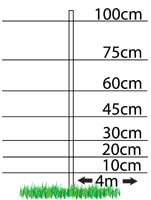When looking to fence chickens, ducks, geese or any poultry you must consider the purpose of the fence. Is it to fence the poultry in, to keep predators like foxes or dogs out or both?
Electric poultry netting and Post & Twine fencing both have their own pro's & con's.
Electric NettingUsing
electric netting for poultry has long been seen as the best electric fence to keep both poultry in and predators out as it provides a 'blanket coverage' going from ground level up to 105cm. The gaps in the netting start off at 5cm horizontal spacings (even bantams won't escape through them) and get increasingly larger as they get higher. The bottom horizontal strand is not electrified as this touches the ground and would cause the fence to earth out.
While a 50m
electric net comes with 15 single spike posts, more posts can be added and these are particularly useful if you have undulating ground. Grass length must be kept in check as if it gets to long it will cause an earth leakage and as the first conductor is only 5cm off the ground, people tend to employ one of three methods to keep it down. We now also stock a version of our green chicken nets in with
double spiked posts>! which have a far better grip on the ground and perfect if your pen has curved edges. For pens that are rectangular in shape we recommend using our !!<
EXTRA STRONG double spiked corner posts as these will strengthen the corners of the net and help reduce power leaking to earth considerably.
- Strimming - just turn off the power, lift up the netting and strim. A bit of a pain and easily put off but the most effective without spraying the grass.
- Plastic Growth Restricter - Strips of plastic pinned down along the fenceline to block out the light from the soil so stifling the vegetation growth. Used extensively on commercial organic farms
- Spray - By spraying Roundup or some other foliage killer, the fenceline is kept clear. Fast acting & very effective but can be unsightly and NOT SUITABLE for those wanting organic status.
If more than one net is needed, they can easily be joined with the clips at the ends. All the conductors from all the horizontal lines come together in a 'tail' with a clip. These will clip together and will give perfect conductivity to as many nets as you choose to attach.
Note - Each
50m net contains 0.5Km of electric fencing and because it can be prone to earth leakages we recommend you use an
energiser which has at least
twice the capacity required and
three times the capacity if the energiser is a smaller one.
Post & Twine / WireThis is also a very effective method of fencing in poultry and keeping foxes / dogs out and it has the advantage of being a more flexible method than using netting as it can hug the contours of the ground very easily.
This method is not as effective at keeping smaller birds in as it doesn't hug the ground as closely as the netting. Also because the feathering on a bird acts as a good insulator, smaller birds can nip under the lines if they spot a dip in the ground. Predators like foxes cannot penetrate the electric fence and this method is the one used on most commercial free range farms in the UK. They tend to have 9 lines of steel wire with small spacings at the bottom and gradually the spacings increase the further up the post they go.

